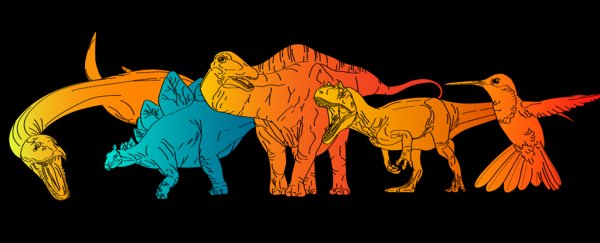Scientists have found a new way to tell whether dinosaurs were hot- or cold-blooded.
This question has long eluded paleontologists, leading to many heated debates where they even accused each other of acting more like politicians than scientists.
Early dinosaur researchers initially assumed these animals were slow, lumbering, and cold-blooded like the modern reptiles they seemed to resemble – their closest reptilian relatives that exist today being crocodilians.
More recently, however, there have been hints that this is not the case.
From metabolic clues in eggshells to the warm-blooded trait of being able to withstand frigid polar conditions, there are growing signs that dinosaurs may have been warm-blooded animals.
Some of them are, after all, direct ancestors of the hot-running birds that have the highest metabolism known today.
Others argued that maybe dinosaurs were neither ectotherms (cold-blooded) nor endotherms (warm-blooded) and that there could be a third option. Mesotherms, like today's turtles, do burn internal energy to regulate their body temperature like endotherms, but not to the same level and consistency as mammals and birds do.
A new method developed by Yale University molecular paleobiologist Jasmina Wiemann now allows researchers to calculate the metabolic rates of dinosaurs using their fossils.
"Metabolism is how effectively we convert the oxygen that we breathe into chemical energy that fuels our body," explains Wiemann. That conversion process makes side products that interact with our bodies' proteins, sugars, and lipids to form chemically stable waste. Animals that are warm-blooded need a higher metabolism to fuel themselves.
It's hard to rely on previous attempts to get metabolic indicators from the knowledge of what temperatures trace minerals in the bones form at because we don't yet understand how the fossilization process alters these minerals. But the stability of the breathing waste product allows it to be fossilized reliably.
We have developed a new proxy that targets the by-products of molecular aerobic respiration. Aerobic respiration involves converting oxygen into chemical energy, a cascade of processes that release heat which eventually determines an animal’s ability to actively thermoregulate... pic.twitter.com/njnIQY2iyU
— Dr. Jasmina Wiemann (@jasmina_wiemann) May 25, 2022
Using the femurs of 55 different animals, including dinosaurs, pterosaurs, plesiosaurs, modern birds, mammals, and lizards, the researchers hunted for signs of this telltale molecular waste.
By comparing the amounts of breathing waste found in the bones across these different still-living species, Wiemann and colleagues were able to work out a scale of waste to metabolic rate. Then, they used this to calculate the metabolism of the extinct animals.
"This is really exciting for us as paleontologists – the question of whether dinosaurs were warm- or cold-blooded is one of the oldest questions in paleontology, and now we think we have a consensus, that most dinosaurs were warm-blooded," says Wiemann.
Some, like the lizard-hipped saurischians – which include Triceratops and Stegosaurus – had metabolic rates similar to the cold-blooded reptiles we know today. But many of the other groups ran hot.
Some ornithischians, including Stegosaurus, Triceratops, and a hadrosaur secondarily reduced their metabolic rates to those found in modern ectotherms (i.e., lizards), suggesting thermoregulatory behaviors such as seasonal migration, sun basking, or preferences for warm climates. pic.twitter.com/go7HaIYe9V
— Dr. Jasmina Wiemann (@jasmina_wiemann) May 25, 2022
Even pterosaurs were warm-blooded, suggesting that endothermy was present in their ornithodiran ancestors before pterosaurs split from their dinosaur relatives. It seems birds' high endothermy is a very ancient trait.
These results rule out the hypothesis that birds and mammals possibly survived the late Cretaceous mass extinction event due to their warm-blooded nature. Many of their contemporary dinosaurs who were wiped out also shared this trait.
"Having a high metabolic rate has generally been suggested as one of the key advantages when it comes to surviving mass extinctions and successfully radiating afterwards," says Wiemann.
"We are living in the sixth mass extinction, so it is important for us to understand how modern and extinct animals physiologically responded to previous climate change and environmental perturbations, so that the past can inform biodiversity conservation in the present and inform our future actions."
Their research was published in Nature.
